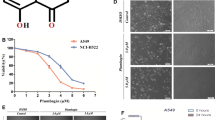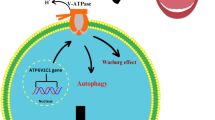Abstract
Bladder cancer is a common cancer with high risk of recurrence and mortality. Intravesicle chemotherapy after trans-urethral resection is required to prevent tumor recurrence and progression. It has been known that antioxidants enhance the antitumor effect of bacillus Calmette-Guerin (BCG), the most effective intravesical bladder cancer treatment. Capsaicin, the major pungent ingredient in genusCapsicum, has recently been tried as an intravesical drug for overactive bladder and it has also been shown to induce apoptotic cell death in many cancer cells. In this study, we investigated the apoptosis-inducing effect and alterations in the cellular redox state of capsaicin in MBT-2 murine bladder tumor cells. Capsaicin induced apoptotic MBT-2 cell death in a time- and dose-dependent manner. The capsaicin-induced apoptosis was blocked by the pretreatment with Z-VAD-fmk, a broad-range caspase inhibitor, or AcDEVD-CHO, a caspase-3 inhibitor. In addition to the caspase-3 activation, capsaicin also induced cytochrome c release and decrease in Bcl-2 protein expression with no changes in the level of Bax. Furthermore, capsaicin at the concentration of inducing apoptosis also markedly reduced the level of reactive oxygen species and lipid peroxidation, implying that capsaicin may enhance the antitumor effect of BCG in bladder cancer treatment. These results further suggest that capsaicin may be a valuable intravesical chemotherapeutic agent for bladder cancers.
Similar content being viewed by others
References
Akaza, H., Hinotsu, S., Aso, Y., Kakizoe, T., and Koiso, K., Bacillus Calmette-Guerin treatment of existing papillary bladder cancer and carcinoma in situ of the bladder. Four-year results.Cancer, 75, 552–559 (1995).
Bombeli, T., Karsan, A., Tait, J. F., and Harlan, J. M., Apoptotic vascular endothelial cells become procoagulant.Blood, 89, 2429–2442 (1997).
Borner, C., The Bcl-2 protein family: sensors and checkpoints for life-or-death decisions.Mol. Immunol., 39, 615–647 (2003).
Cerutti, P. A., Prooxidant states and tumor promotion.Science, 227, 375–381 (1985).
Cordell, G. A. and Araujo, O. E., Capsaicin: identification, nomenclature, and pharmacotherapy.Ann. Pharmacother., 27, 330–336 (1993).
Denis, G., Humblet, C., Verlaet, M., Boniver, J., and Defresne, M. P., p53, Bax and Bcl-2in vivo expression in the murine thymus after apoptogenic treatments.Anticancer Res., 18, 3315–3321 (2000).
De Ridder, D., Chandiramani, V., Dasgupta, P., Van Poppel, H., Baert, L., and Fowler, C. J., Intravesical capsaicin as a treatment for refractory detrusor hyperreflexia: a dual center study with long-term followup.J. Urol., 158, 2087–2092 (1997).
Galati, G. and O’Brien, P. J., Cytoprotective and anticancer properties of coenzyme Q versus capsaicin.Biofactors, 18, 195–205 (2003).
Green, D. R. and Reed, J. C., Mitochondria and apoptosis.Science, 281, 1309–1312 (1998).
Gross, A., McDonnell, J. M., and Korsmeyer, S. J., BCL-2 family members and the mitochondria in apoptosis.Genes Dev, 13, 1899–1911 (1999).
Haunstetter, A. and Izumo, S., Apoptosis; basic mechanism and implications for cardiovascular disease.Circ. Res., 82, 1111–1129 (1998).
Herrmann, M., Lorenz, H. M., Vollm, R., Grunkem, M., Woithm, W., and Kaldenm, J. R., A rapid and simple method for the isolation of apoptotic DNA fragments.Nucleic Acids Res., 22, 5506–5507 (1994).
Ito, K., Nakazato, T., Yamato, K., Miyakawa, Y., Yamada, T., Hozumi, N., Segawa, K., Ikeda, Y., and Kizaki, M., Induction of apoptosis in leukemic cells by homovanillic acid derivative, capsaicin, through oxidative stress: implication of phosphorylation of p53 at Ser-15 residue by reactive oxygen species.Cancer Res., 64, 1071–1078 (2004).
Jemal, A., Murray, T., Samuels, A., Ghafoor, A., Ward, E., and Thun, M. J.,Cancer statistics, 2003.CA Cancer J. Clin., 53, 5–26 (2003).
Jung, M. Y., Kang, H. J., and Moon, A., Capsaicin-induced apoptosis in SK-Hep-1 hepatocarcinoma cells involves Bcl-2 downregulation and caspase-3 activation.Cancer Lett., 165, 139–145 (2001).
Kang, H. J., Soh, Y., Kim, M. S., Lee, E. J., Surh, Y. J., Kim, H. R., Kim, S. H., and Moon, A., Roles of JNK-1 and p38 in selective induction of apoptosis by capsaicin in rastransformed human breast epithelial cells.Int. J. Cancer, 103, 475–482 (2003).
Lamm, D. L., Superficial bladder cancer.Curr. Treat. Options Oncol., 3, 403–411 (2002).
Lee, Y. S., Nam, D. H., and Kim, J. A., Induction of apoptosis by capsaicin in A172 human glioblastoma cells.Cancer Lett., 161, 121–130 (2000).
Lee, Y. S., Kwon, E. J., Jin, D. Q., Park, S. H., Kang, Y. S., Huh, K., and Kim, J. A. Redox status-dependent regulation of cyclooxygenases mediates the capsaicin-induced apoptosis in human neuroblastoma cells.J. Environ. Pathol. Toxicol. Oncol., 21, 113–120 (2002).
Lee, Y. S., Kang, Y. S., Lee, J. S., Nikolova, S., and Kim, J. A., Involvement of NADPH oxidase-mediated generation of reactive oxygen species in the apototic cell death by capsaicin in HepG2 human hepatoma cells.Free Rad. Res., 38, 405–412 (2004).
Liu, X., Kim, C. N., Yang, J., Jemmerson, R., and Wang, X., Induction of apoptotic program in cell-free extracts; Requirement for dATP and cytochromec.Cell, 86, 147–157 (1996).
Mosmann, T., Rapid colorimetric assay for cellular growth and survival: application to proliferation and cytotoxicity assays.J. Immunol. Methods, 65, 55–63 (1983).
Pook, S. H., Esuvaranathan, K., and Mahendran, R.,N-Acetylcysteine augments the cellular redox changes and cytotoxic activity of internalized mycobacterium bovis in human bladder cancer cells.J. Urol., 168, 780–785 (2002).
Sternberg, C. N., A critical review of the management of bladder cancer.Crit. Rev. Oncol. Hematol., 31, 193–207 (1999).
Surh, Y. J. and Lee, S. S., Capsaicin, a double-edged sword: toxicity, metabolism, and chemopreventive potential.Life Sci., 56, 1845–1855 (1995).
Surh, Y. J., Lee E., and Lee, J. M., Chemoprotective properties of some pungent ingredients present in red pepper and ginger.Mutat. Res., 402, 259–267 (1998).
Surh, Y. J., More than spice: capsaicin in hot chili peppers makes tumor cells commit suicide.J. Natl. Cancer Inst. 94, 1263–1265 (2002).
Suzuki, T. and Iwai, K., Constitution of red pepper species: chemistry, biochemistry, pharmacology, and food science of the pungent principle of Capsicum species, in: A. Brosi (Ed.), The Alkaloides, 23, Academic Press, New York, 1994, pp. 227–299.
Szatrowski, T. P. and Nathan, C. F., Production of large amounts of hydrogen peroxide by human tumor cells.Cancer Res., 51, 794–798 (1991).
Tanaka, T., Kohno, H., Sakata, K., Yamada, Y., Hirose, Y., Sugie, S., and Mori, H., Modifying effects of dietary capsaicin and rotenone on 4-nitroquinoline l-oxide-induced rat tongue carcinogenesis.Carcinogenesis, 23, 1361–1367 (2002).
Tanaka, T., Kohno, H., Sakata, K., Yamada, Y., Hirose, Y., Sugie, S., and Mori, H., Modifying effects of dietary capsaicin and rotenone on 4-nitroquinoline l-oxideinduced rat tongue carcinogenesis.Carcinogenesis, 23, 1361–1367 (2002).
Tu, Y., Xu, F. H., Liu, J., Vescio, R., Berenson, J., Fady, C., and Lichtenstein, A., Upregulated expression of BCL-2 in multiple myeloma cells induced by exposure to doxorubicin, etoposide, and hydrogen peroxide.Blood, 88, 1805–1812 (1996).
Zhang, J., Nagasaki, M., Tanaka, Y., and Morikawa, S., Capsaicin inhibits growth of adult T-cell leukemia cells.Leuk. Res., 27, 275–283 (2003).
Author information
Authors and Affiliations
Corresponding author
Rights and permissions
About this article
Cite this article
Lee, JS., Chang, JS., Lee, J.Y. et al. Capsaicin-induced apoptosis and reduced release of reactive oxygen species in MBT-2 Murine Bladder Tumor cells. Arch Pharm Res 27, 1147–1153 (2004). https://doi.org/10.1007/BF02975121
Received:
Issue Date:
DOI: https://doi.org/10.1007/BF02975121




